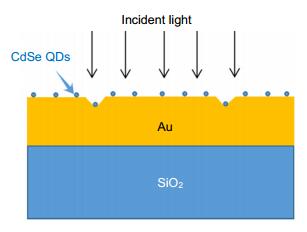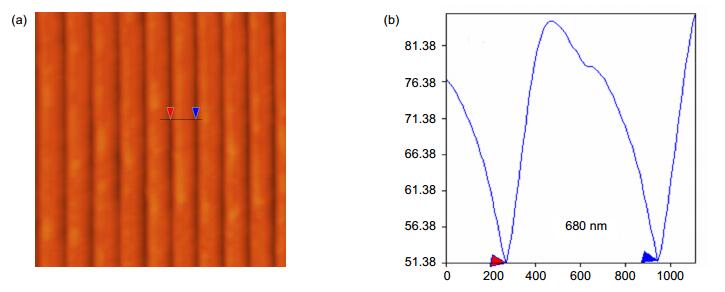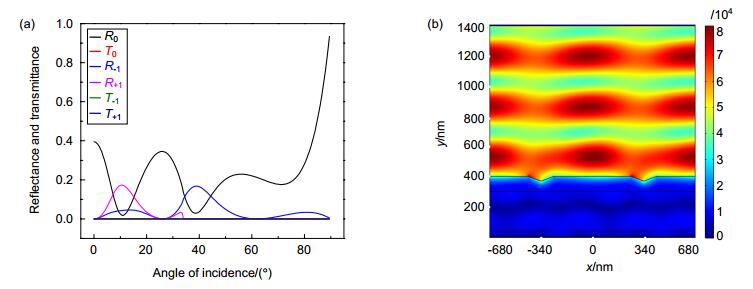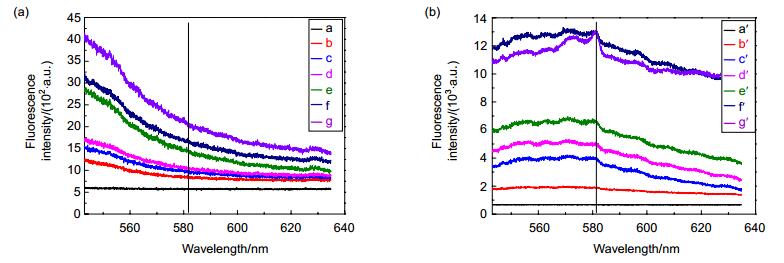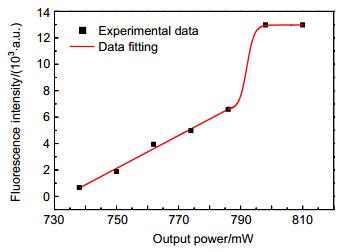Surface plasma enhanced fluorescence of CdSe quantum dots induced by laser on a grating surface
-
摘要
利用532 nm皮秒脉冲激光在金纳米光栅表面诱导表面等离子体激发CdSe量子点荧光,并测量了CdSe量子点荧光增强效应。分别采用AFM刻蚀方法和自组装方法在硅基金膜表面制备了纳米光栅/CdSe量子点的多层薄膜结构。通过调节皮秒脉冲激光的功率,在显微拉曼平台上测量了CdSe量子点的荧光光谱。结果表明,金纳米光栅/CdSe量子点结构能够实现量子点远场荧光大幅增强,其最大荧光强度达7.80倍,并在达到最大强度点开始迅速饱和。该研究结果可广泛应用于光电器件、生物医学检测研究等领域。

Abstract
The fluorescence enhancement effect of CdSe quantum dots (QDs) was measured by using a picosecond pulsed laser with a 532 nm excitation wavelength to induce surface plasmon (SP) on a gold nanograting surface. A layered thin film was prepared on the gold film surface of silicon fund by atomic force microscope (AFM) etching and self-assembly method, respectively. The fluorescence spectrum of CdSe QDs was measured by adjusting the power of picosecond pulsed laser on a micro-Raman measuring platform. The results showed that the structure of the gold nanograting and CdSe QDs could greatly enhance the far-field fluorescence of CdSe QDs, the maximum fluorescence intensity was up to 7.80 times, and it had been saturated rapidly at the point of reaching the maximum intensity. The results of this study could be widely used in fields of the optoelectronic devices, biomedical detection.
-
Overview

Overview: In recent years, the fluorescence technology has been greatly developed, but in practical applications, the sensitivity of the existing fluorescence detection technology is not satisfactory. Semiconductor quantum dots can exhibit higher luminous efficiency and stronger brightness compared to conventional fluorescent dyes, and their emitted light wavelengths can cover almost the entire visible light region, thus, it has been widely used in bio-detection, biomarker and optoelectronic device development. However, the commonly used quantum dots tend to have low fluorescence emission intensity, and the fluorescence stability needs to be further improved, which greatly limits its application. Therefore, the technology based on surface plasmon enhanced quantum dots fluorescence has become a new method for reducing fluorescence noise and improving sensitivity, and it has developed rapidly for this reason.
In the 1970s, Drexhage discovered the phenomenon of surface-enhanced fluorescence, but until the end of the 20th century, Lakowicz and his colleagues experimentally studied the effect of metal nanostructures on enhancing fluorescence, and made great contributions to the mechanism and application of surface-enhanced fluorescence, it begun to attract people's attention. And today, surface-enhanced fluorescence technology based on nanostructures has been widely used in the fields of DNA nondestructive testing, biosensing analysis, and single molecule detection. In recent years, research on the use of various metal nanostructures to enhance quantum dot fluorescence has also made a great progress. However, the mechanism of interaction between metal nanostructures and quantum dots is still not unified, and the control of coupling ligands between quantum dots and nanostructures is still one of the hot issues in current scientific research. In this paper, a nanograting structure was prepared on gold film surface of silicon fund by AFM force etching method, and CdSe quantum dots with organic molecular ligands were attached to the surface of nanograting by self-assembly technique. A multilayers film structure of nanograting/CdSe quantum dots were prepared. The fluorescence spectrum of the CdSe quantum dots was measured by adjusting the picosecond laser (with 532 nm excitation wavelengths) power on a micro-Raman measuring platform. The results showed that the structure of the gold nanograting and CdSe QDs could greatly enhance the far-field fluorescence of CdSe QDs, the maximum fluorescence intensity was up to 7.80 times, and it had been saturated rapidly at the point of reaching the maximum intensity. The results of this study could be widely used in fields of the optoelectronic devices, biomedical detection.
-

-
图 7 CdSe量子点荧光谱及其不同衬底上的增强荧光谱。(a) CdSe量子点荧光谱;(b) 543 nm~640 nm波段CdSe量子点荧光谱(1),光栅结构CdSe量子点增强荧光谱(2),无光栅结构CdSe量子点增强荧光谱(3)
Figure 7. CdSe QDs fluorescence spectra and it's enhanced fluorescence spectra on different substrates. (a) Fluorescence spectrum of CdSe QDs; (b) Fluorescence spectrum of CdSe QDs (543 nm~640 nm) (1), grating structure CdSe QDs enhanced fluorescence spectrum (2), non-grating CdSe QDs enhanced fluorescence spectrum (3)
表 1 有无光栅衬底上CdSe的荧光数值及其强度关系
Table 1. Relationship between fluorescence values and intensity of CdSe on a different substrate
Excitation intensity/mW 738 750 762 774 786 798 810 Grating structure 676.21 1887.11 3947.21 4969.40 6589.16 12973.88 12973.88 Without grating structure 570.06 849.20 978.94 1053.64 1450.72 1663.02 2087.62 Enhancement factor 1.19 2.22 4.03 4.72 4.54 7.80 6.21 -
参考文献
[1] 刘楠, 洪志良.用于生物荧光检测的CMOS光电探测器设计[J].光电工程, 2008, 35(7): 140-144. doi: 10.3969/j.issn.1003-501X.2008.07.028
Liu N, Hong Z L. Design of CMOS process compatible photodetectors for fluorescence detecting application[J]. Opto-Electronic Engineering, 2008, 35(7): 140-144. doi: 10.3969/j.issn.1003-501X.2008.07.028
[2] 杨晓博, 闫卫平.表面贴附微透镜阵列的OLED诱导荧光检测系统[J].光电工程, 2015, 42(1): 6-12. doi: 10.3969/j.issn.1003-501X.2015.01.002
Yang X B, Yan W P. OLED-induced fluorescence detection system affixed with micro lens array for capillary electrophoresis microchip[J]. Opto-Electronic Engineering, 2015, 42(1): 6-12. doi: 10.3969/j.issn.1003-501X.2015.01.002
[3] Fort E, Grésillon S. Surface enhanced fluorescence[J]. Journal of Physics D: Applied Physics, 2008, 41(1): 013001. doi: 10.1088/0022-3727/41/1/013001
[4] Drexhage K H. Influence of a dielectric interface on fluorescence decay time[J]. Journal of Luminescence, 1970, 1-2: 693-701. doi: 10.1016/0022-2313(70)90082-7
[5] Turner E H, Lauterbach K, Pugsley H R, et al. Detection of green fluorescent protein in a single bacterium by capillary electrophoresis with laser-induced fluorescence[J]. Analytical Chemistry, 2007, 79(2): 778-781. doi: 10.1021/ac061778r
[6] Lakowicz J R, Shen B, Gryczynski Z, et al. Intrinsic fluorescence from DNA can be enhanced by metallic particles[J]. Biochemical and Biophysical Research Communications, 2001, 286(5): 875-879. doi: 10.1006/bbrc.2001.5445
[7] Abel B, Coskun S, Mohammed M, et al. Metal-enhanced fluorescence from silver nanowires with high aspect ratio on glass slides for biosensing applications[J]. The Journal of Physical Chemistry C, 2015, 119(1): 675-684. doi: 10.1021/jp509040f
[8] Aslan K, Lakowicz J R, Szmacinski H, et al. Enhanced ratiometric pH sensing using SNAFL-2 on silver island films: metal-enhanced fluorescence sensing[J]. Journal of Fluorescence, 2005, 15(1): 37-40. doi: 10.1007/s10895-005-0211-0
[9] Resch-Genger U, Grabolle M, Cavaliere-Jaricot S, et al. Quantum dots versus organic dyes as fluorescent labels[J]. Nature Methods, 2008, 5(9): 763-775. doi: 10.1038/nmeth.1248
[10] Xiong L H, Cui R, Zhang Z L, et al. Uniform fluorescent nanobioprobes for pathogen detection[J]. ACS Nano, 2014, 8(5): 5116-5124. doi: 10.1021/nn501174g
[11] Hong Z Y, Lv C, Liu A A, et al. Clicking hydrazine and aldehyde: the way to labeling of viruses with quantum dots[J]. ACS Nano, 2015, 9(12): 11750-11760. doi: 10.1021/acsnano.5b03256
[12] 刘锋, 朱俊, 魏俊峰, 等.量子点敏化太阳电池[J].化学进展, 2013, 25(2-3): 409-418. http://d.old.wanfangdata.com.cn/Periodical/wlhxxb201507013
Liu F, Zhu J, Wei J F, et al. Quantum dot-sensitized solar cells[J]. Progress in Chemistry, 2013, 25(2-3): 409-418. http://d.old.wanfangdata.com.cn/Periodical/wlhxxb201507013
[13] Peng B, Li Z P, Mutlugun E, et al. Quantum dots on vertically aligned gold nanorod monolayer: plasmon enhanced fluorescence[J]. Nanoscale, 2014, 6(11): 5592-5598. doi: 10.1039/C3NR06341K
[14] Kannegulla A, Liu Y, Cheng L J. Surface-plasmon-enhanced photoluminescence of quantum dots based on open-ring nanostructure array[J]. Proceedings of SPIE, 2016, 9758: 97580B. doi: 10.1117/12.2212132
[15] Peer A, Hu Z J, Singh A, et al. Photoluminescence enhancement of CuInS2 quantum dots in solution coupled to plasmonic gold nanocup array[J]. Small, 2017, 13(33): 1700660. doi: 10.1002/smll.201700660
[16] Hao L C, Bai Z C, Qin S J, et al. The effect of differential temperatures on the latent heat in the nucleation of CdSe quantum dots[J]. Journal of Semiconductors, 2017, 38(4): 042004. doi: 10.1088/1674-4926/38/4/042004
[17] Bai Z C, Hao L C, Zhang Z P, et al. Measuring photoluminescence spectra of self-assembly array nanowire of colloidal CdSe quantum dots using scanning near-field optics microscopy[J]. Functional Materials Letters, 2016, 9(3): 1650040. doi: 10.1142/S1793604716500405
[18] Deng Z T, Cao L, Tang F Q, et al. A new route to zinc-blende CdSe nanocrystals: mechanism and synthesis[J]. The Journal of Physical Chemistry B, 2005, 109(35): 16671. doi: 10.1021/jp052484x
[19] 林佼, 王大鹏, 司光远.表面等离子激元超构表面的研究进展[J].光电工程, 2017, 44(3): 289-296. doi: 10.3969/j.issn.1003-501X.2017.03.003
Lin J, Wang D P, Si G Y. Recent progress on plasmonic metasurfaces[J]. Opto-Electronic Engineering, 2017, 44(3): 289-296. doi: 10.3969/j.issn.1003-501X.2017.03.003
[20] Yao M, Zhou F, Shi J P, et al. Nanoparticle coupling effect allows enhanced localized field on Au bowl-like pore arrays[J]. RSC Advances, 2016, 6(36): 29958-29962. doi: 10.1039/C5RA25336E
[21] Dong K X, Ji Y P, Mi J J, et al. High sensitivity SPR sensor for liquid phase sample with Ag/PbS/Graphene hybrid nanostructure[J]. Opto-Electronic Engineering, 2017, 44(2): 198-201. http://www.wanfangdata.com.cn/details/detail.do?_type=perio&id=gdgc201702010
[22] Hutter E, Fendler J H. Exploitation of localized surface Plasmon resonance[J]. Advanced Materials, 2004, 16(19): 1685-1706. doi: 10.1002/(ISSN)1521-4095
[23] Bauch M, Toma K, Toma M, et al. Plasmon-enhanced fluorescence biosensors: a review[J]. Plasmonics, 2014, 9(4): 781-799. doi: 10.1007/s11468-013-9660-5
[24] Dneprovskii V S, Zhukov E A, Lyaskovskii V L, et al. Luminescence of CdSe/Al2O3 quantum wires at high photoexcitation levels[J]. Physics of the Solid State, 2004, 46(9): 1755-1760. doi: 10.1134/1.1799198
-
访问统计


 E-mail Alert
E-mail Alert RSS
RSS
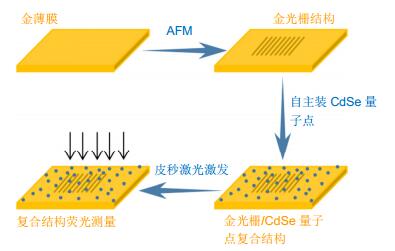
 下载:
下载:
